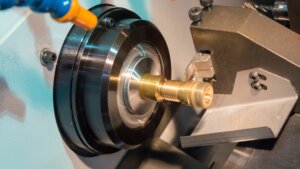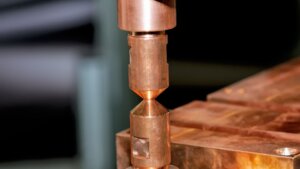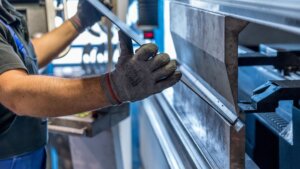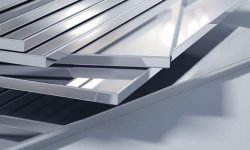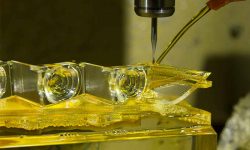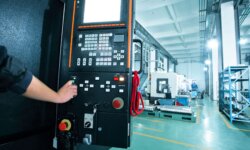Copper, renowned for its electrical and thermal conductivity, plays a pivotal role in modern manufacturing and is a common material used in CNC machining. This guide delves deep into the world of copper machining, unraveling its intricacies, techniques, and applications. It’s not just about shaping a metal; it’s about harnessing copper’s unique properties to create components essential to various industries.
What is Copper Machining?
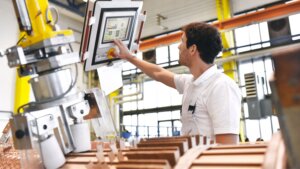
Copper machining refers to the process of cutting, shaping, or modifying copper material using various techniques to achieve desired geometries and dimensions. This process is crucial in producing highly precise and intricate copper parts used in numerous applications.
Key Aspects of Copper Machining:
- Exceptional electrical and thermal conductivity
- Ability to create complex shapes and precise dimensions
- Versatility in applications ranging from electronics to aerospace
How does Copper Machining work?
Copper machining works by removing material from a copper workpiece to achieve the desired shape and size. This can be done through various methods like milling, turning, drilling, and more, each suitable for different types of designs and requirements.
What are the Common Techniques for Copper Machining?
Copper machining involves a variety of techniques, each selected based on the project’s specific needs. These techniques cater to different design requirements and application areas.
CNC Milling
CNC milling, a cornerstone in copper machining, uses rotating cutting tools to carve out copper. This method’s precision is unmatched, making it ideal for complex parts and detailed designs.
CNC Turning
In CNC turning, the copper piece rotates against a fixed cutting tool, primarily used for crafting cylindrical components. This technique is efficient and versatile, suitable for both internal and external machining.
Drilling
Drilling creates precise round holes in copper, essential for components requiring fastening or bolting. Both drill presses and milling machines can be utilized for this purpose.
Tapping
Tapping involves cutting threads within drilled holes, facilitating the insertion of bolts or screws. This process can be manual or CNC-driven for added precision.
Grinding
Grinding achieves fine finishes and exact dimensions using an abrasive wheel. This technique is often a finishing step, refining parts machined by other methods.
Electrical Discharge Machining (EDM)
For copper parts demanding extreme precision, EDM is the go-to method. It uses electrical sparks to meticulously shape copper, ideal for complex geometries.
Water Jet Cutting
Water jet cutting employs a high-pressure water stream, sometimes mixed with abrasives, to slice through copper. It’s especially beneficial for cutting thick copper sheets without heat distortion.
What is the Best Tool to Machine Copper?
The choice of the right tool is crucial in copper machining. The nature of copper, known for its malleability and conductivity, demands tools that can handle its unique properties while ensuring precision and quality.
General Guidelines for Effective Tools:
- Durability: Tools made from high-grade materials like carbide or high-speed steel (HSS) to resist wear.
- Precision: Sharp, well-designed tools for intricate designs and tight tolerances.
- Compatibility: Tools that work harmoniously with CNC machines for optimal performance in copper CNC machining services.
Different Grades of Copper Used in Machining
Pure Copper
Pure copper, also known as cathode copper, offers high electrical conductivity. It’s typically used in electrical applications but can be challenging to machine due to its softness.
Electrolytic Copper
With high purity, electrolytic copper is preferred for electronic applications. Its electrical and thermal conductivity make it an excellent choice for heat exchangers and wiring.
Oxygen-Free Copper
Known for its superb conductivity and ductility, oxygen-free copper is ideal for high-quality audiovisual equipment and vacuum electronics. Its low oxygen content reduces the risk of hydrogen embrittlement.
Free-Machining Copper
Free-machining copper alloys, like those containing lead, improve machinability. They are frequently used in applications where ease of machining is crucial, albeit with slightly reduced conductivity.
Best Copper Grade for Machining
When it comes to machining, selecting the right copper grade is paramount. Each grade offers unique properties, influencing its suitability for specific applications. For instance, free-machining copper grades, while easier to machine, might not offer the same conductivity as pure or oxygen-free copper.
Copper with Best Mechanical Strength
Among copper grades, those alloyed with elements like tin or zinc often exhibit superior mechanical strength. These grades are typically chosen for parts that demand durability alongside conductivity.
Precision and Tolerance in Copper Machining
Achieving high precision and maintaining tight tolerances are key in copper machining. Factors affecting precision include:
- Machine calibration and stability
- Tool quality and suitability
- Material properties of the copper grade
- Operator skill and experience
Understanding these factors and controlling them is crucial for quality copper machining, especially in precision-driven industries like aerospace and electronics.
Applications of Copper Machining
Copper machining finds its place in a myriad of industrial applications, thanks to its excellent electrical and thermal conductivity. Here are some notable applications:
- Electrical Components: From wiring to connectors, copper’s conductivity makes it indispensable.
- Heat Exchangers: Leveraging its thermal properties for efficient heat transfer.
- Aerospace Components: Where strength and conductivity are both required.
Choosing the Right Copper Alloy for Specific Applications
Selecting the right copper alloy is a critical decision in machining projects. Factors to consider include:
- Required electrical or thermal conductivity
- Mechanical strength needed
- Specific application requirements like corrosion resistance or machinability
Primary Benefits and Challenges of Machining Copper
Advantages of Copper Machining
- Superior Conductivity: Both electrical and thermal.
- Versatility: Suitable for a wide range of applications.
- Recyclability: Copper can be recycled without loss of properties.
Challenges in Copper Machining
- Work Hardening: Copper can harden during machining, affecting tool life.
- Thermal Expansion: Managing heat generation during machining.
What are the Factors to Consider When Machining Copper?
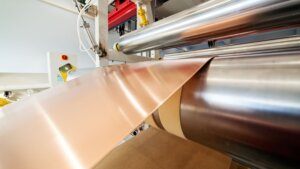
Choosing the Right Copper Material Grade
The grade influences machinability, strength, and conductivity.
Designing for Manufacturability
Optimizing design to leverage copper’s properties while ensuring efficient machining.
Setting the Correct Feed Rate
Balancing speed and precision to minimize tool wear and achieve desired finishes.
Selecting the Appropriate Tool Material
Tools that can withstand copper’s unique characteristics, ensuring longevity and precision.
Design Considerations for Effective Copper Machining
When designing for copper machining, consider:
- Complexity of the Part: Ensuring the design is feasible with available machining techniques.
- Material Properties: Accounting for copper’s physical characteristics in the design phase.
- Tolerances and Finish: Balancing precision requirements with copper’s machinability.
Key Safety Tips for Copper Machining
In copper machining, safety is paramount. Key practices include:
- Proper Ventilation: To manage copper particles and dust.
- Regular Tool Maintenance: Ensuring tools are in optimal condition.
- Adherence to Safety Protocols: Following guidelines for machine operation and material handling.
Common Problems and Solutions in Copper Machining
Copper machining, while offering numerous benefits, also presents its own set of challenges, such as burr formation, work hardening, and tool wear. Addressing these issues is crucial for maintaining the quality and efficiency of the machining process.
- Burr Formation: Often a result of improper tooling or machining parameters. Solutions include using sharp tools, optimizing feed rates, and employing proper cooling techniques.
- Work Hardening: Copper can harden unexpectedly during machining. Countermeasures include using lower cutting speeds and ensuring continuous, uninterrupted cuts.
- Tool Wear: Due to copper’s softness and high thermal conductivity, tools can wear quickly. Using carbide or polycrystalline diamond (PCD) tools can help increase tool life.
What Are the Costs Involved in Copper Machining?
Cost Factors in Copper CNC Machining
Costs in copper machining vary based on several factors:
- Material Grade: Different copper grades, like oxygen-free or electrolytic copper, have varying prices.
- Complexity of Machining: More intricate designs require more time and precision, increasing costs.
- Tooling and Equipment: Advanced tools and machines can add to the overall expense.
Costs can range from moderate for simpler tasks to significantly higher for complex or high-precision machining.
Comparing Costs of Different Copper Machining Techniques
Each machining technique comes with its own cost implications:
- CNC Milling and Turning: Generally more cost-effective for mass production.
- EDM and Water Jet Cutting: Higher costs due to the precision and equipment involved.
- Drilling and Tapping: Relatively lower costs, suitable for simpler operations.
How to Ensure Quality in Copper Machining Processes?
Quality in copper machining is non-negotiable. Key quality control measures include:
- Regular Inspection: Frequent checks during the machining process to ensure tolerances and specifications are met.
- Tool Maintenance: Ensuring tools are sharp and well-maintained to avoid defects.
- Process Optimization: Continuously refining machining parameters for optimal results.
- Integration of 3D Printing: Complementing traditional machining with additive manufacturing for complex designs.
The Economic Impact of Copper Machining
Copper machining holds significant economic importance. Its applications in critical industries like electronics, aerospace, and automotive underscore its economic value. The cost-effectiveness of machining copper, especially when compared to other materials, contributes to its widespread use and industrial significance.
Why is Copper Machining Important in Modern Manufacturing?
Copper machining is integral to modern manufacturing due to its:
- Versatility: Used in a wide range of products, from electrical components to decorative items.
- Conductivity: Essential in electrical and thermal applications.
- Machinability: Offers a balance of workability and durability, making it a preferred choice in many sectors.
Alternatives to CNC Machining for Copper
While CNC machining is prevalent, alternative methods include:
- Hand Machining: For simpler or one-off projects.
- Laser Cutting: For precise, non-contact cutting of thinner copper sheets.
- Stamping and Forming: Cost-effective for producing copper parts in large volumes.
Environmental and Health Considerations in Copper Machining
Copper machining, like any industrial process, poses environmental and health considerations. Proper disposal of copper chips and coolants is crucial to minimize environmental impact. Health aspects involve ensuring adequate ventilation and protective equipment to safeguard against copper dust and particles.
Conclusion
In summary, copper machining is a sophisticated and essential part of modern manufacturing. Its versatility, conductivity, and machinability make it a valuable material across various industries. Despite its challenges, advancements in machining technologies continue to enhance its applications and efficiency.
3ERP is a leading provider of copper machining services and capable of producing parts in various coatings and finishes depending on your project requirements.
We produce corrosion-resistant copper machined parts and can handle solid copper bars, copper-nickel alloys, and CNC turning or milling of copper alloy materials.
Frequently Asked Questions About Copper Machining
1. Is Copper Easy to Machine?
Copper is generally considered easy to machine, but it requires proper tooling and parameters to manage its softness and potential for work hardening.
2. How to Optimize Machining for Different Copper Alloys?
Optimizing machining for different copper alloys involves selecting the right tools, adjusting machining speeds and feeds, and considering the specific properties of each alloy, such as hardness and conductivity.


